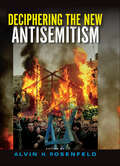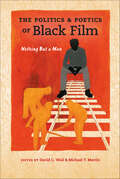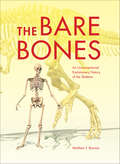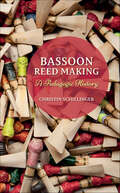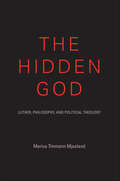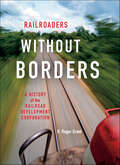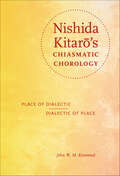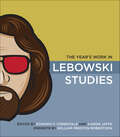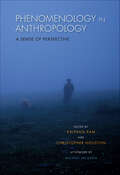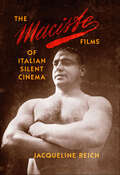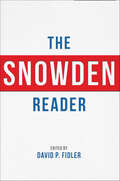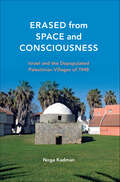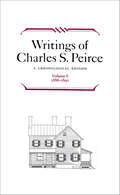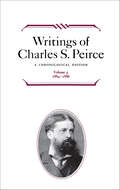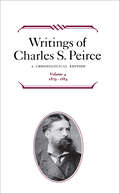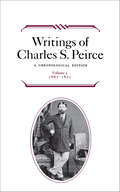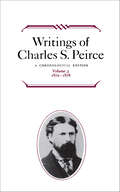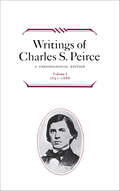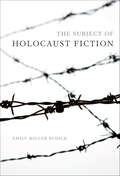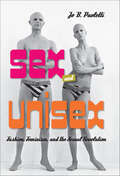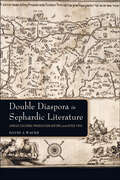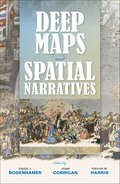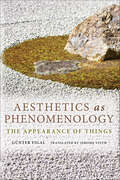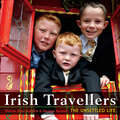- Table View
- List View
Deciphering the New Antisemitism (Studies in Antisemitism)
by Alvin H. RosenfeldDeciphering the New Antisemitism addresses the increasing prevalence of antisemitism on a global scale. Antisemitism takes on various forms in all parts of the world, and the essays in this wide-ranging volume deal with many of them: European antisemitism, antisemitism and Islamophobia, antisemitism and anti-Zionism, and efforts to demonize and delegitimize Israel. Contributors are an international group of scholars who clarify the cultural, intellectual, political, and religious conditions that give rise to antisemitic words and deeds. These landmark essays are noteworthy for their timeliness and ability to grapple effectively with the serious issues at hand.
The Politics & Poetics of Black Film: Nothing But a Man (Studies in the Cinema of the Black Diaspora)
by Michael T. Martin David C. WallWritten and directed by two white men and performed by an all-black cast, Nothing But a Man (Michael Roemer, 1964) tells the story of a drifter turned family man who struggles with the pressures of small-town life and the limitations placed on him and his community in the Deep South, an area long fraught with racism. Though unmistakably about race and civil rights, the film makes no direct reference to the civil rights movement. Despite this intentional absence, contemporary audiences were acutely aware of the social context for the film's indictment of white prejudice in America. To help frame and situate the film in the context of black film studies, the book gathers primary and secondary resources, including the original screenplay, essays on the film, statements by the filmmakers, and interviews with Robert M. Young, the film's producer and cinematographer, and Khalil Gibran Muhammad, the Director of the Schomburg Center for Research in Black Culture.
The Bare Bones: An Unconventional Evolutionary History of the Skeleton (Life of the Past)
by Matthew F. BonnanWhat can we learn about the evolution of jaws from a pair of scissors? How does the flight of a tennis ball help explain how fish overcome drag? What do a spacesuit and a chicken egg have in common? Highlighting the fascinating twists and turns of evolution across more than 540 million years, paleobiologist Matthew Bonnan uses everyday objects to explain the emergence and adaptation of the vertebrate skeleton. What can camera lenses tell us about the eyes of marine reptiles? How does understanding what prevents a coffee mug from spilling help us understand the posture of dinosaurs? The answers to these and other intriguing questions illustrate how scientists have pieced together the history of vertebrates from their bare bones. With its engaging and informative text, plus more than 200 illustrative diagrams created by the author, The Bare Bones is an unconventional and reader-friendly introduction to the skeleton as an evolving machine.
Bassoon Reed Making: A Pedagogic History
by Christin SchillingerWithheld by leading pedagogues in an effort to control competition, the art of reed making in the early 20th century has been shrouded in secrecy, producing a generation of performers without reed making fluency. While tenets of past decades remain in modern pedagogy, Christin Schillinger details the historical pedagogical trends of bassoon reed making to examine the impact different methods have had on the practice of reed making and performance today. Schillinger traces the pedagogy of reed making from the earliest known publication addressing bassoon pedagogy in 1687 through the publication of Julius Weissenborn's Praktische Fagott-Schule and concludes with an in-depth look at contemporary methodologies developed by Louis Skinner, Don Christlieb, Norman Herzberg, and Lewis Hugh Cooper. Aimed at practitioners and pedagogues of the bassoon, this book provides a deeper understanding of the history and technique surrounding reed-making craft and instruction.
The Hidden God: Luther, Philosophy, and Political Theology (Philosophy of Religion)
by Marius Timmann MjaalandIn this phenomenological reading of Luther, Marius Timmann Mjaaland shows that theological discourse is never philosophically neutral and always politically loaded. Raising questions concerning the conditions of modern philosophy, religion, and political ideas, Marius Timmann Mjaaland follows a dark thread of thought back to its origin in Martin Luther. Thorough analyses of the genealogy of secularization, the political role of the apocalypse, the topology of the self, and the destruction of metaphysics demonstrate the continuous relevance of this highly subtle thinker.rabbi
Railroaders without Borders: A History of the Railroad Development Corporation (Railroads Past and Present)
by H. Roger GrantFor over 25 years, the creatively led Railroad Development Corporation (RDC) has rejuvenated a series of down-and-out and even defunct railroads. Launched in 1987 by Henry Posner III, this investment and management company has demonstrated that it is possible both to have a conscience and to earn a profit in today's railroad industry. With ventures on four continents, RDC has created an admirable record of long-term commitments, respect for local cultures, and protection of the public interest. H. Roger Grant presents a firsthand look at this unique business operation and its triumphs and disappointments.
Nishida Kitaro's Chiasmatic Chorology: Place of Dialectic, Dialectic of Place (World Philosophies)
by John W. KrummelNishida Kitaro (1870–1945) is considered Japan's first and greatest modern philosopher. As founder of the Kyoto School, he began a rigorous philosophical engagement and dialogue with Western philosophical traditions, especially the work of G. W. F. Hegel. John W. M. Krummel explores the Buddhist roots of Nishida's thought and places him in connection with Hegel and other philosophers of the Continental tradition. Krummel develops notions of self-awareness, will, being, place, the environment, religion, and politics in Nishida's thought and shows how his ethics of humility may best serve us in our complex world.
The Year's Work in Lebowski Studies (The Year's Work)
by William Preston RobertsonA massive underground sensation, The Big Lebowski has been hailed as the first cult film of the internet age. In this book, 21 fans and scholars address the film's influences—westerns, noir, grail legends, the 1960s, and Fluxus—and its historical connections to the first Iraq war, boomers, slackerdom, surrealism, college culture, and of course bowling. The Year's Work in Lebowski Studies contains neither arid analyses nor lectures for the late-night crowd, but new ways of thinking and writing about film culture.
Phenomenology in Anthropology: A Sense of Perspective
by Michael JacksonThis volume explores what phenomenology adds to the enterprise of anthropology, drawing on and contributing to a burgeoning field of social science research inspired by the phenomenological tradition in philosophy. Essays by leading scholars ground their discussions of theory and method in richly detailed ethnographic case studies. The contributors broaden the application of phenomenology in anthropology beyond the areas in which it has been most influential—studies of sensory perception, emotion, bodiliness, and intersubjectivity—into new areas of inquiry such as martial arts, sports, dance, music, and political discourse.
The Maciste Films of Italian Silent Cinema
by Jacqueline ReichItalian film star Bartolomeo Pagano's "Maciste" played a key role in his nation's narratives of identity during World War I and after. Jacqueline Reich traces the racial, class, and national transformations undergone by this Italian strongman from African slave in Cabiria (1914), his first film, to bourgeois gentleman, to Alpine soldier of the Great War, to colonial officer in Italy's African adventures. Reich reveals Maciste as a figure who both reflected classical ideals of masculine beauty and virility (later taken up by Mussolini and used for political purposes) and embodied the model Italian citizen. The 12 films at the center of the book, recently restored and newly accessible to a wider public, together with relevant extra-cinematic materials, provide a rich resource for understanding the spread of discourses on masculinity, and national and racial identities during a turbulent period in Italian history. The volume includes an illustrated appendix documenting the restoration and preservation of these cinematic treasures.
The Snowden Reader
by David P. FidlerWhen Edward Snowden began leaking NSA documents in June 2013, his actions sparked impassioned debates about electronic surveillance, national security, and privacy in the digital age. The Snowden Reader looks at Snowden's disclosures and their aftermath. Critical analyses by experts discuss the historical, political, legal, and ethical issues raised by the disclosures. Over forty key documents related to the case are included, with introductory notes explaining their significance: documents leaked by Snowden; responses from the NSA, the Obama administration, and Congress; statements by foreign leaders, their governments, and international organizations; judicial rulings; findings of review committees; and Snowden's own statements. This book provides a valuable introduction and overview for anyone who wants to go beyond the headlines to understand this historic episode.
Peasant Fires: The Drummer of Niklashausen
by Richard Wunderli" . . . lively and intellectually stimulating . . . " —Speculum"Wunderli . . . has lucidly reconstructed a controversial conflict in 15th-century south-central Germany. . . . this engaging narrative takes off from Hans Behem—the peasant who claimed to see the Virgin and gained followers until crushed by the established church—to explore larger forces at work in Germany on the eve of the Reformation. . . Wunderli also attempts to sort out the violent conflict that ensued and Hans's subsequent trial. His scrupulousness and sensitivity make for a small but valuable book." —Publishers Weekly"Fascinating and well written, this is highly recommended for academic and larger public libraries." —Library Journal"Richard Wunderli . . . deftly tells the story in Peasant Fires, finding in it a foreshadowing of peasant uprisings in the 16th century." —New York Times Book Review" . . . a stimulating read . . . an engaging synthesis." —Central European HistoryIn 1476, an illiterate German street musician had a vision of the Virgin Mary and began to preach a radical social message that attracted thousands of followers—and antagonized the church. The drummer was burned at the stake. This swiftly moving narrative of his rise and fall paints a vivid portrait of 15th-century German society as it raises important questions about the craft of history."A gem of a book. . . . It has a plot, good guys and bad buys, it opens up a 'strange' world, and it is exceptionally well written." —Thomas W. Robisheaux
Erased from Space and Consciousness: Israel and the Depopulated Palestinian Villages of 1948
by Noga KadmanHundreds of Palestinian villages were left empty across Israel when their residents became refugees after the 1948 war, their lands and property confiscated. Most of the villages were razed by the new State of Israel, but in dozens of others, communities of Jews were settled—many refugees in their own right. The state embarked on a systematic effort of renaming and remaking the landscape, and the Arab presence was all but erased from official maps and histories. Israelis are familiar with the ruins, terraces, and orchards that mark these sites today—almost half are located within tourist areas or national parks—but public descriptions rarely acknowledge that Arab communities existed there within living memory or describe how they came to be depopulated. Using official archives, kibbutz publications, and visits to the former village sites, Noga Kadman has reconstructed this history of erasure for all 418 depopulated villages.
Writings of Charles S. Peirce: A Chronological Edition (Writings of Charles S. Peirce)
by Charles S. PeirceVolume 6 of this landmark edition contains 66 writings mainly from the unsettled period in Peirce's life just after he moved from New York to Milford, Pennsylvania, followed shortly afterward by the death of his mother. The writings in this volume reveal Peirce's powerful mind probing into diverse issues, looking for an underlying unity, but, perhaps, also looking for direction.
Writings of Charles S. Peirce: A Chronological Edition (Writings of Charles S. Peirce)
by Charles S. Peirce"Highly recommended." —Choice" . . . an important event for the world of philosophy. For the first time we have available in an intelligible form the writings of one of the greatest philosophers of the past hundred years." —The Times Literary SupplementVolume 5 of this landmark edition covers an important transition in Peirce's life, marked by a rekindled enthusiasm for speculative philosophy. The writings include essays relating to his all-embracing theory of categories as well as papers on logic and mathematics.
Writings of Charles S. Peirce: A Chronological Edition (Writings of Charles S. Peirce)
by Charles S. Peirce"The volumes are handsomely produced and carefully edited, . . . For the first time we have available in an intelligible form the writings of one of the greatest philosophers of the past hundred years . . . " —The Times Literary Supplement" . . . an extremely handsome and impressive book; it is an equally impressive piece of scholarship and editing." —Man and World
Writings of Charles S. Peirce: A Chronological Edition (Writings of Charles S. Peirce)
by Charles S. Peirce"For anyone seriously interested in Peirce, or in nineteenth-century American philosophy, or in American intellectual history, or in philosophy in general, or in semiotics and its philosophical import, these volumes should be required reading." —Murray G. Murphey, Semiotica
Writings of Charles S. Peirce: A Chronological Edition (Writings of Charles S. Peirce)
by Charles S. PeirceThe PEIRCE EDITION contains large sections of previously unpublished material in addition to selected published works. Each volume includes a brief historical and biographical introduction, extensive editorial and textual notes, and a full chronological list of all of Peirce's writings, published and unpublished, during the period covered.
Writings of Charles S. Peirce: A Chronological Edition (Writings of Charles S. Peirce)
by Charles S. PeirceThe PEIRCE EDITION contains large sections of previously unpublished material in addition to selected published works. Each volume includes a brief historical and biographical introduction, extensive editorial and textual notes, and a full chronological list of all of Peirce's writings, published and unpublished, during the period covered.
The Subject of Holocaust Fiction (Jewish Literature And Culture Ser.)
by Emily Miller BudickFictional representations of horrific events run the risk of undercutting efforts to verify historical knowledge and may heighten our ability to respond intellectually and ethically to human experiences of devastation. In this captivating study of the epistemological, psychological, and ethical issues underlying Holocaust fiction, Emily Miller Budick examines the subjective experiences of fantasy, projection, and repression manifested in Holocaust fiction and in the reader's encounter with it. Considering works by Cynthia Ozick, Art Spiegelman, Aharon Appelfeld, Michael Chabon, and others, Budick investigates how the reading subject makes sense of these fictionalized presentations of memory and trauma, victims and victimizers.
Sex and Unisex: Fashion, Feminism, and the Sexual Revolution
by Jo B. PaolettiNotorious as much for its fashion as for its music, the 1960s and 1970s produced provocative fashion trends that reflected the rising wave of gender politics and the sexual revolution. In an era when gender stereotypes were questioned and dismantled, and when the feminist and gay rights movements were gaining momentum and a voice, the fashion industry responded in kind. Designers from Paris to Hollywood imagined a future of equality and androgyny. The unisex movement affected all ages, with adult fashions trickling down to school-aged children and clothing for infants. Between 1965 and 1975, girls and women began wearing pants to school; boys enjoyed a brief "peacock revolution," sporting bold colors and patterns; and legal battles were fought over hair style and length. However, with the advent of Diane Von Furstenberg's wrap dress and the launch of Victoria's Secret, by the mid-1980s, unisex styles were nearly completely abandoned. Jo B. Paoletti traces the trajectory of unisex fashion against the backdrop of the popular issues of the day—from contraception access to girls' participation in sports. Combing mass-market catalogs, newspaper and magazine articles, cartoons, and trade publications for signs of the fashion debates, Paoletti provides a multigenerational study of the "white space" between (or beyond) masculine and feminine.
Double Diaspora in Sephardic Literature: Jewish Cultural Production Before and After 1492 (Sephardi and Mizrahi Studies)
by David A. WacksThe year 1492 has long divided the study of Sephardic culture into two distinct periods, before and after the expulsion of Jews from Spain. David A. Wacks examines the works of Sephardic writers from the 13th to the 16th centuries and shows that this literature was shaped by two interwoven experiences of diaspora: first from the Biblical homeland Zion and later from the ancestral hostland, Sefarad. Jewish in Spain and Spanish abroad, these writers negotiated Jewish, Spanish, and diasporic idioms to produce a uniquely Sephardic perspective. Wacks brings Diaspora Studies into dialogue with medieval and early modern Sephardic literature for the first time.
Deep Maps and Spatial Narratives (The Spatial Humanities)
by John Corrigan David J. Bodenhamer Trevor M. HarrisDeep maps are finely detailed, multimedia depictions of a place and the people, buildings, objects, flora, and fauna that exist within it and which are inseparable from the activities of everyday life. These depictions may encompass the beliefs, desires, hopes, and fears of residents and help show what ties one place to another. A deep map is a way to engage evidence within its spatio-temporal context and to provide a platform for a spatially-embedded argument. The essays in this book investigate deep mapping and the spatial narratives that stem from it. The authors come from a variety of disciplines: history, religious studies, geography and geographic information science, and computer science. Each applies the concepts of space, time, and place to problems central to an understanding of society and culture, employing deep maps to reveal the confluence of actions and evidence and to trace paths of intellectual exploration by making use of a new creative space that is visual, structurally open, multi-media, and multi-layered.
Aesthetics as Phenomenology: The Appearance of Things (Studies in Continental Thought)
by Günter FigalConnecting aesthetic experience with our experience of nature or with other cultural artifacts, Aesthetics as Phenomenology focuses on what art means for cognition, recognition, and affect—how art changes our everyday disposition or behavior. Günter Figal engages in a penetrating analysis of the moment at which, in our contemplation of a work of art, reaction and thought confront each other. For those trained in the visual arts and for more casual viewers, Figal unmasks art as a decentering experience that opens further possibilities for understanding our lives and our world.
Irish Travellers: The Unsettled Life
by George Gmelch Sharon Bohn GmelchAnthropologists George and Sharon Gmelch have been studying the quasi-nomadic people known as Travellers since their fieldwork in the early 1970s, when they lived among Travellers and went on the road in their own horse-drawn wagon. In 2011 they returned to seek out families they had known decades before—shadowed by a film crew and taking with them hundreds of old photographs showing the Travellers' former way of life. Many of these images are included in this book, alongside more recent photos and compelling personal narratives that reveal how Traveller lives have changed now that they have left nomadism behind.
